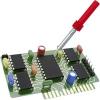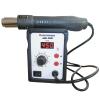| www.tmatlantic.com
Test & Soldering Equipment On-line Store |
|
D.E.V.I.C.E. (Wiki)Calculators Services |
|||||
Filter by first letter
|
Common electronic components repairs and hand soldering techniquesSearch by section D.E.V.I.C.E. services
Soldering is a process in which two or more metal items are joined together by melting a filler metal into the joint.

Solder is metal alloy usually made of tin and lead which is melted using a hot iron. The iron is heated to temperatures above 600 degrees Fahrenheit which then cools to create a strong electrical bond. On July 1, 2006, a directive was adopted restricting the inclusion of lead in most consumer electronics sold in the EU, and having a broad effect on consumer electronics sold worldwide. In the US, manufacturers may receive tax benefits by reducing the use of lead-based solder. Lead-free solders in commercial use may contain tin, copper, silver, bismuth, indium, zinc, antimony, and traces of other metals.
Solder paste works as an adhesive, connecting surface components to pads on the board. It also provides electrical and thermal connection. 
Flux is used in both manual hand soldering as well as the different automated processes used by PCB contract manufacturers. The main purpose of the flux is to prepare the metal surfaces for soldering by cleaning and removing any oxides and impurities. 
At the end of most soldering irons is an interchangeable part known as a soldering tip. There are many variations of this tip and they come in a wide variety of shapes and sizes. Each tip is used for a specific purpose and offers a distinct advantage over another. The most common tips you will use in electronics projects are the conical tip and the chisel tip. 
A soldering station is a multipurpose power soldering device designed for electronic components soldering. This type of equipment is mostly used in electronics and electrical engineering. Soldering station consists of one or more soldering tools connected to the main unit, which includes the controls (temperature adjustment), means of indication, and may be equipped with an electric transformer. 
Desoldering stations are great for removing solder to make repairs to components. Most have in-built vacuums to draw the melted solder away and keep the circuit board clean as you work. 
Solder tweezers combine the squeezing action of mechanical tweezers with a heating action. This allows you to grip small electronic devices while simultaneously heating them for desoldering. They provide a fast and efficient method for desoldering electronic components such as fixed resistors.

These stations send hot air through the device to warm solder for removal or resoldering. An all-in-one hot air rework station can meet these needs without requiring multiple devices. Hot air rework stations come in many sizes to accommodate different printed circuit board sizes. 
Soldering activities produce fumes that are dangerous and toxic. Soldering fan incorporates a ball bearing high volume fan to maximize airflow which is directed upwards at the rear of the unit to aid in safe dispersion of fumes.
Surface-mount technology (SMT) is a method in which the electrical components are mounted directly onto the surface of a printed circuit board (PCB). In industry, this approach has largely replaced the through-hole technology construction method of fitting components, in large part because SMT allows for increased manufacturing automation which reduces cost and improves quality. 
A surface-mount device or SMD is an electronic device for which the components are mounted or placed directly onto the surface of the PCB. RoHS is often referred to as the "lead-free" directive, but it restricts the use of six substances: lead, mercury, cadmium, chromium VI (also known as hexavalent chromium), and PBB and PBDE (flame retardants used in some plastics). Relating to electrical and electronic assemblies and components in which the lead (Pb) level in any of the raw materials and the end product is less than or equal to 0.1% by weight and that also meet the Pb-free requirements/definitions adopted by the RoHS Directive 2002/95/EC. |
Measurement History Events
|
Site mapPrivacy policyTerms of Use & Store PoliciesHow to BuyShippingPayment




|


























